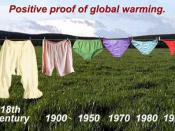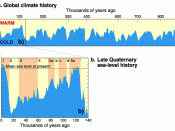The Arctic Circle is melting at the rate of twice as fast as the global rate due to global warming. The effect of the Arctic Circle warming faster than the rest of the world is that it raises sea level substantially. The projections for the future show a two to three times higher warming rate than for the rest of the world. The picture on the next page shows the difference in the melting of ice from the year 1979 to 2003. Over nine percent shrunk in those twenty-four years. The data from the picture was collected by several satellites and there pictures put together and formed into a rendered picture. The data used to create these images come from a variety of different instruments flying on a group of satellites; they include the scanning multi-channel microwave radiometer attached to the Nimbus 7 satellite, and the special sensor microwave imagers attached to the Defense Meteorological Satellite Program's F8, F11, and F13 satellites.
The data shows a continues effect on the melting of the Artic Circle. Soon there will be no circle any more. Less ice means more open water therefore, more open water means greater absorption of energy from the sun. More absorption of energy from the sun means increased rates of warming in the ocean which then goes back around the loop to melting ice but at a faster rate. The picture also show that the rate of warming in the Arctic over the last twenty years is eight times the rate of warming over the last one-hundred years! Arctic summer sea ice reached the lowest level in the satellite record in 2003 and the sea ice melt season has increased by 10 to 17 days per decade. Soon there will be no ice season.
This data...


